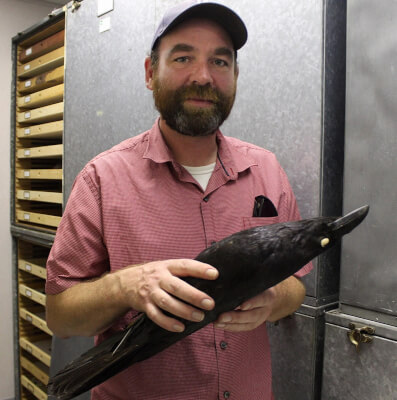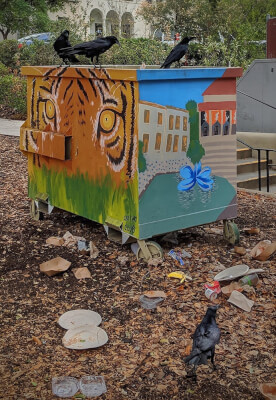
A conspiracy of ravens and a murder of crows inhabit Occidental’s campus, setting the ambiance for Halloween with their chilling sounds and ominous appearance. They can be seen watching students from a perch on an oak tree in the quad or squawking over the best food scraps in the dumpster outside the Tiger Cooler. According to adjunct professor James Maley, the collections manager of the Moore Lab of Zoology, crows and ravens are often associated with wickedness and evil.
“I think it’s because they’re black and they make these weird noises,” Maley said. “It’s because of their curiosity that they’re often standing around, kind of checking you out, and I think people think that they look like they have evil intentions.”
According to Maley, people think of these birds as voracious murderers, with the misconception that their diet consists of only baby birds and baby mammals.
“They do a lot of other stuff besides just that,” Maley said. “But if you see a raven picking a baby bird out of a nest, you know, it looks pretty evil.”
Leeza Lu (sophomore) is a student researcher in the Moore Lab and is currently working alongside Maley to manage the lab’s collections. According to Lu, people are scared of these birds because of their intelligence.
“People are scared of things that are smarter than them. We as humans like to have control over things and know what we can do and feel safe, but these are smart birds that know how to figure their way through things,” Lu said.
Contrary to the Western outlook on these birds, ravens are considered sacred in many different Native American cultures, particularly in the Northwest and Alaska, according to Maley.
Occidental is home to common ravens (Corvus corax) and American crows (Corvus brachyrhynchos). According to Maley, both species have benefitted from urbanization in Los Angeles.

“Common raven fossils have been found at La Brea [Tar Pits], so they’ve been here for thousands of years. Common ravens were locally common in appropriate habitats before LA was really settled,” Maley said. “They require cliffs and lone trees to nest in. Us building all of this stuff has provided them with a lot more places to nest, so they have increased pretty substantially over the past 150 years.”
According to Maley, these birds generally keep their distance from each other unless there is a food source — such as an animal carcass — or, in more urban settings, trash. One can witness this phenomenon outside of the Tiger Cooler, where Occidental’s crows and ravens rummage through the dumpster and trash bins looking for food.
“They’re omnivores, which has allowed them to be so successful in urban areas because they can eat just about anything. They wouldn’t be eating garbage that’s bad for them. They generally do not eat rotten things. They’re not like vultures in that way,” Maley said.
Lu sees Occidental’s trash as a sustainable food source for the birds.
“They don’t have to go looking for food when there are just piles of thrown away food in the trash cans,” Lu said. “It’s energy efficient, I suppose, because they don’t have to go looking for snails or little insects or whatever when they can just pick through the trash.”
Rowdy Freeland (senior) is conducting a project on Occidental’s ravens for his field ecology class to build a model of how ravens utilize space and resources across campus.
“I’m going to be taking a bunch of data points of where ravens are on campus at what times, and if they’re eating something off the ground or if they’re using trash and try to see how the presence of trash, plants or trees in certain places determines where they are across campus at any given time,” Freeland said.
Freeland’s suspicion is that trash is the reason behind Occidental’s large resident raven population.
“I think that they rely on the trash as a food source, and that’s why they’re able to thrive and make a home here,” Freeland said. “It will be interesting to see what effect there is on their population here if people take measures to keep the trash in the receptacles that they’re placed in and prevent them from using it for food.”
Lu said these are tricky birds with a reputation for causing trouble. According to Associate Director of Campus Dining Robert Starec, who oversees the Tiger Cooler, the birds eating the garbage jeopardize the beauty of the Cooler and create extra work for Facilities staff.
“The trash ends up on the ground, which is not only an eyesore, but it also becomes a health issue having trash all over the ground,” Starec said. “The biggest impact is on the groundskeepers who have to not only empty that bin but clean the area around it.”
According to Starec, Campus Dining is working with Facilities to find a solution to stop these birds from getting into the trash. Facilities Sustainability Coordinator Jenny Low is stepping in to address the problem.
“For the receptacles, what’s being worked on is to see if the current dumpsters can be retrofitted to have a lid,” Low said. “Those lids are pretty heavy, so the birds themselves won’t be able to lift it unless they develop a pulley system or something.”
Although the chance of the birds developing such a system is unlikely, they are highly intelligent creatures, according to Maley. They even have a capacity for facial recognition.
“They can recognize people’s individual faces, and they can recognize each other,” Maley said. “There’s another closely related species, magpies, that can identify themselves in a mirror. This is probably also true for crows and ravens, but I don’t know that it’s been tested. The only other species with this ability are humans and porpoises, which kind of gives you an idea of the level of how smart they are.”
There are a variety of ways to tell crows and ravens apart, particularly the way they sound, according to Maley.
“They sound very different,” Maley said. “Crows generally just make a cawing noise, but ravens make all kinds of weird noises. The ravens are the ones making that super loud chortling. They do a lot of croaking. So that’s one big thing: if you can hear them and it’s croaking, it’s definitely a raven.”
According to Maley, a close-up look at ravens and crows is the easiest way to differentiate among the species.
“Ravens are almost twice as big as crows,” Maley said. “The ravens have a ruff of feathers in their throat that they puff out when they’re croaking, and crows don’t have that. Ravens have a much bigger bill relative to their body than crows do. The tail is the easiest way: when they’re in flight, as the tail on a raven is a wedge shape and it’s squared off in a crow.”
According to Lu, the Occidental community has every reason to fear these birds.
“They can recognize your face. So if you mess with them, they’ll come back and attack you, potentially. People are afraid of crows and ravens, and you know, they should be because they’re so smart and they can recognize your face, which is scary,” Lu said.
![]()


































